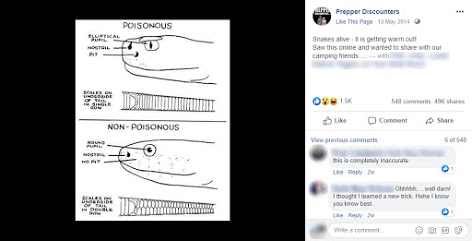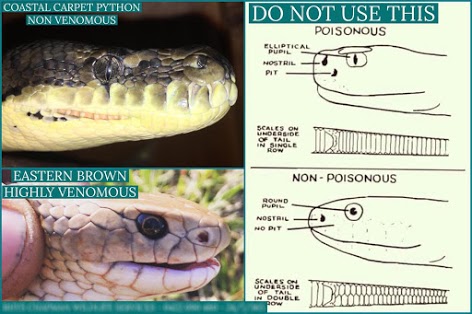The Statement
AAP FactCheck examined a Facebook post by Prepper Discounters on May 13, 2014 of a diagram claiming to show how to identify “poisonous” snakes.

The drawn diagram shows the head and underside of a tail of two snakes. With arrows pointing to each characteristic, the diagram claims elliptical pupils, thermal sensing pits and a single row of scales on the underside of a snake indicate it is “poisonous”. The second diagram claims round pupils, no thermal sensing pits and two rows of scales on the underside of a snake show it is “non-poisonous”.
At the time of publication, the post had been shared 49,000 times, and attracted more than 540 comments and 1500 reactions. Prepper Discounters are an online store “providing basic essentials to maintain a normal lifestyle in the event of anything that disrupts our daily routine” based in Columbus, Ohio.
The Analysis
Pupils and pits on snakes both serve practical purposes unrelated to whether or not a snake is venomous. Elliptical pupils tend to be a trait of nocturnal snakes, while snakes active during the day have round pupils, according to an article on identifying venomous snakes published by McGill University in Canada.
The pits on a snake’s head are thermal sensors used to help find prey and regulate body temperature. While venomous “pit vipers” found in the US have these sensors, so do pythons, which are constrictors and not venomous.
The United States only has four types of venomous snakes. Three of those – rattlesnakes, copperheads and cottonmouths, also known as water moccasins – fit the diagram. However, the coral snake has round pupils and no thermal sensing pits.
Rhys Chapman, a snake catcher in Australia – home to many of the most venomous snakes in the world – told AAP FactCheck the diagram was not relevant outside a “specific region in the USA” and urged Facebook users not to be fooled. “The diagram is completely incorrect and not valid here in Australia, for starters snakes are venomous not poisonous,” he told AAP FactCheck.
Mr Chapman also provided AAP FactCheck with a photo proving the diagram wrong (pictured above). The photo shows a highly venomous Eastern Brown snake, which had round pupils and no thermal sensing pits, qualities the diagram claims make it non-venomous. It also shows a non-venomous coastal carpet python which has the physical characteristics the diagram claims are features of venomous snakes.
Richie Gilbert, a snake catcher from Queensland with over 80,000 likes on Facebook also debunked the image in 2015, around the time the picture first began to gain prominence. He implored users not to share it. “It seems this image was based on snakes for the USA although I’m not sure if it’s even reliable for over there,” he wrote. “There is no one single rule that can help distinguish between venomous and non-venomous here in Australia.”
The Verdict
Based on this evidence, AAP FactCheck found the Facebook post claiming to demonstrate a method of identifying venomous snakes to be false. It applies only to American land snakes and contradicts the advice of snake catchers and professionals.
False – The Facebook post is false.
* AAP FactCheck is an accredited member of the International Fact-Checking Network. To keep up with our latest fact checks, follow us on Facebook, Twitter and Instagram.
First published Friday July 12, 2019 15:10 AEST


















